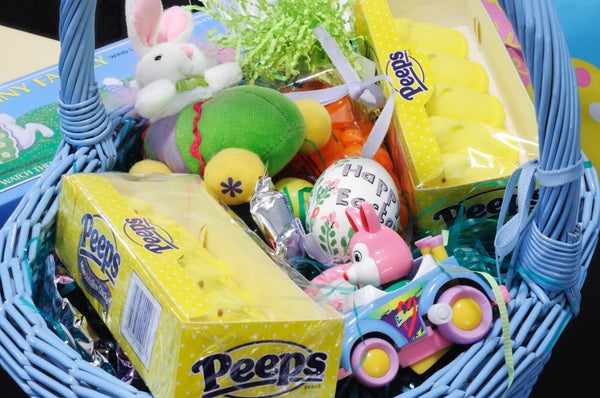This article was published in Scientific American’s former blog network and reflects the views of the author, not necessarily those of Scientific American
Part of the Easter festivities today may include giving children baskets of goodies, which are left ostensibly by the Easter Bunny. That absolutely is the case in my household. My baskets have been packed and ready to go for weeks because I gave said Bunny a hand in getting things ready. But while Easter eggs and the Easter Bunny have significant histories of their own, the Easter basket is almost accidental in nature. And in recent years, its complex make-up has rendered it a prime marketing opportunity as is reflected by the varied items people put in their baskets.
From its Pagan roots, Easter is ultimately a celebration of Spring. This is a period traditionally where life returns to an otherwise stark and cold landscape, therefore it’s not surprising that the key representatives of this season—the egg and the rabbit—are so heavily steeped in fertility symbolism. This idea of the “coming of life” would have fit nicely with the Christian idea of Christ’s resurrection, ensuring their transmission through the ages.
Baskets do have a role to play in that particular narrative. They’re symbolic nests, after all, and are specifically used by children in modern Easter egg hunts to carry their prizes. Filled to the brim with eggs and other treasures, they are the epitome of birth and potential. The idea of the basket itself is also very old, so as a vehicle of transmission, it’s not hard to imagine that they were featured in Spring visitations throughout history; perhaps they were used to bear gifts or transport seedlings or simply to bring food to communal meals. (Baskets tend to be rather utilitarian in that way.)
On supporting science journalism
If you're enjoying this article, consider supporting our award-winning journalism by subscribing. By purchasing a subscription you are helping to ensure the future of impactful stories about the discoveries and ideas shaping our world today.
It has become customary, however, to fill baskets with more than just these symbols of the holiday. Where chocolate bunnies and plastic eggs once reigned supreme, they are now being crowded out in favor of, well, practically anything since almost everything can be repackaged for an Easter gift. Retailers know this well. In 2016, Easter sales reached $680 million, which included food, clothing, gifts, candy, flowers, decorations, and greeting cards. The later date for Easter this year was tied to a forecast that people would be more likely to splurge on Easter-related items, which is thanks in part, possibly, to a longer marketing window, but also for psychological reasons. Spring is a preparatory season. People undertake large-scale cleaning projects as they look to purge themselves of old items, which necessitates the purchase of new items. The diversity within Easter baskets suggests that one method of justifying these purchases comes from Easter itself.
In baskets this year (as in recent years past), the public trend in parents groups has been to downplay candy. “What can I put in my Easter basket that stimulates learning? Or does anyone have any other non-candy ideas?” is a question that’s been posted multiple times in many of the online parenting groups I belong to in past weeks. The responses have varied from clothing (like socks and tights and shirts) to accessories (like barrettes or necklaces or belts) to books to gift cards to school supplies, and yes of course, to toys as well. Some parents have talked about “big” Easter gifts in the form of an electronic device (phone, tablet, laptop) or other age-appropriate item. And a small percentage maintain that they are not doing baskets but focusing on the experience of being together as a family, instead.
Easter baskets have become a indicator of status and means as much as they are a part of the Easter tradition. They demonstrate personal wealth in that being able to provide a basket, and fill it with non-traditional Easter items, implies that you are doing well financially. Baskets and their contents can range anywhere from approximately $10 onward, and that is supposing that the purchaser is a bargain shopper at a discount store.* And that by extension you are passing some of that wealth onto someone else, particularly if you are giving them things they can use. The basket themselves become reflective of status. A family or person that is not doing well, isn’t going to have the means to participate in this particular form of consumerism.
While a great many baskets are given to children, it’s not uncommon for adults to give each other gifts in this spirit. The receipt of a gift implies you belong, and the quality of that gift, may be interpreted as a reflection of how well you are liked.
Like so many Easter traditions, the Easter basket has come a generic event that is tenuously tied to Easter and the religious tones of the holiday. This broad appeal further drives its marketability and opens the door for greater displays of status.
Did you give or receive an Easter basket today? What was in it? Comments have been disabled on Anthropology in Practice, but you can always join the community on
*Basket, plastic eggs, and grass, as well as other Easter items can be purchased for $1.00 each at a dollar variety store if purchased early while supplies are available.
--
Referenced:
Schmidt, Leigh Eric. “The Easter Parade: Piety, Fashion, and Display.” Religion and American Culture: A Journal of Interpretation, Vol. 4( 2), 1994, pp. 135–164.
--
You might also like:
The Tradition of Eggs at Easter
Ashes, Yarmulkes and the Hijab: Communitas and Religious Symbols
—
Image Credit: Ralph Daily
